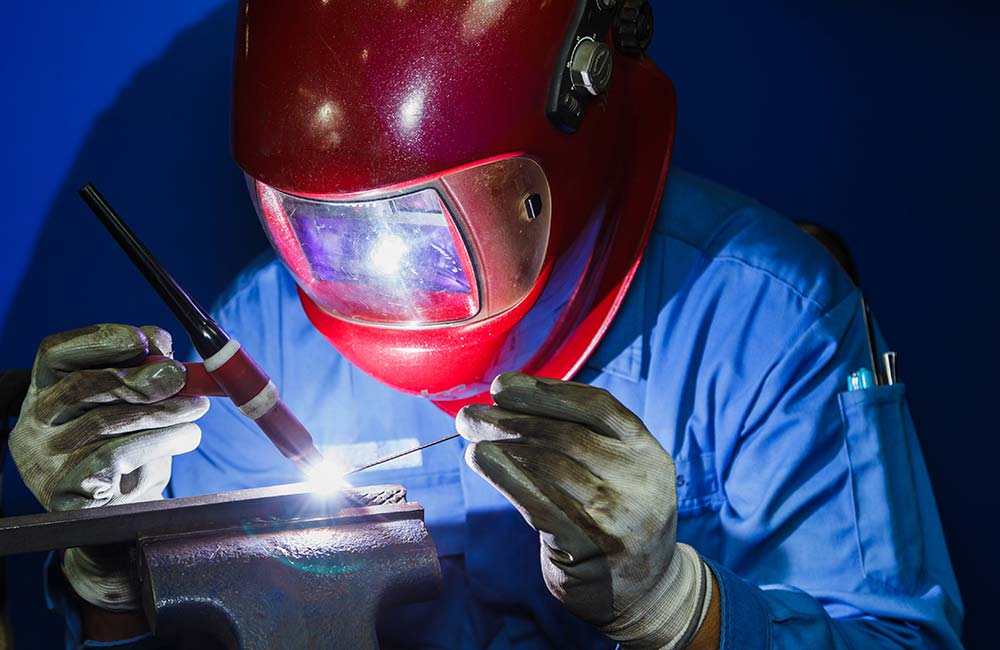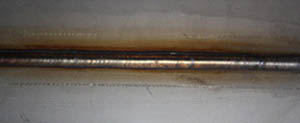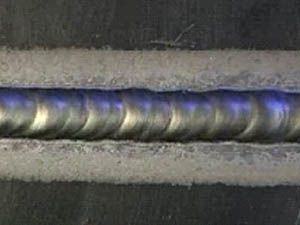TIG Welding

Arc welding with an infusible electrode and inert gas protection is commonly called TIG (Tungsten Inert Gas). TIG welding is an autogenous process in which heat is produced by an arc striking between the workpiece and an infusible electrode (an electrode that is not consumed).
The electrode is made of tungsten or tungsten alloys. These materials have very high melting temperatures, with excellent thermionic emission properties that facilitate operation of the electric arc.
TIG welding melts the edges of the workpiece. Chopstick filler material is used to create the joints. During the welding process, the torch discharges inert gas. The flow of gas protects the electrode, the solder bath, the bow, filler material and adjacent areas of the piece from atmospheric contamination.
TIG welding is suitable for all types of carbon steels, low-alloy steels, alloyed stainless, nickel alloys, aluminum and its alloys, copper and its alloys, titanium, magnesium, and other nonferrous alloys.
The use of an infusible electrode makes TIG welding particularly suited for metals only a few millimeters thick. Because the electrode is not consumed, welding can be performed without filler material. Welders enjoy good control of the solder bath because visibility is not hampered and no metal transfer occurs in the arc. The process is suitable for any working position and can also be applied on laminations a few tenths of a mm thick.
TIG welding’s intense and concentrated heat source permits discrete welding speeds and melts the edges of the workpiece without excessive risk of breakthrough. Modulating the current allows operators to fine-tune the process to meet special requirements.
TIG welding’s intense and concentrated heat source permits discrete welding speeds and melts the edges of the workpiece without excessive risk of breakthrough. Modulating the current allows welders to fine-tune the process to meet special requirements. The TIG process is widely used to create high-quality joints when working with sensitive materials that can’t tolerate high temperatures needed to create a weld.
For welding thick metals, TIG is inefficient and rarely used.
TIG Welding of Stainless Steels
TIG welding is used for welding austenitic stainless steels. The techniques are similar to those used for welding carbon steels and low alloy steels, with a few minor differences:
- Since the weld is much more fluid, operators must increase the welding speed as necessary when working in different positions from the plane.
- Cleaning before welding is much more important, given the greater sensitivity of these steels to the formation of cracks (hot) in the molten zone.
- Special filters for the output of the torch and the cap on the reverse side of the metal reduce coloring of the welding bead (surface oxidation). (Figure 4).
- Waiting a few moments to remove the torch once welding is completed prevents oxidation of the crater.
- Cleaning and machining stainless steel always require clean accessories not contaminated by low-alloy steels.
Welding Parameters and Variables
TThe most suitable welding parameters are determined by the diameter and type of electrode (pure or additivated), the type of gas, and the power mode of the arc. The inclination of the torch follows the same techniques indicated for MIG/MAG welding.

- 1) Torch close to the surface
- 2) Torch far from the surface
- 3) Tilted torch
- 4) Perpendicular torch
When an inclined torch is held close to the metal base, the welding bead appears clean and tight. In contrast, bringing the torch further from the base metal and holding it perpendicular to the workpiece tends to increase the heat-affected zone.
To lower the risk of operational defects in manual applications, employ the push technique with angles around 15°. Typically, automatic TIG welding involves holding the torch perpendicular to the workpiece. This guarantees intermediate results but assists in the management of filler metal.
Both DC and AC currents can manage the power. With direct polarity (Figure 2), TIG creates a very deep and narrow melting bath and allows for a high feed rate. This results in fewer withdrawals and distortions and only minor consequences to the base metal. In addition, limited heating slows the consumption of the tungsten electrode and allows electrodes with a smaller diameter to withstand rather high currents. But the direct mode is subject to fluctuations, causing alterations in the thermal regime of the arc.


DC power is advantageous when working with metals like aluminum coated with an infusible oxide film. Applying the current causes ion blasting, breaking the bond between the coating and metal.
As the current continues to reverse polarity, the end of the electrode tends to overheat. Eventually the electrode melts, taking on a rounded shape and dispersing small drops of tungsten in the bath. The quickly eroding electrode causes unacceptable defects in the weld and splashes of tungsten inclusions in the solder. For these reasons, it cannot exceed 100 A.
When the polarity of direct current is reversed, high welding currents cannot be used. The electrode rapidly erodes, causing a wide solder bath and inadequate joint penetration
When welding oxide-coated materials with currents greater than 100 A, the welder must feed the torch with alternating current. Ion blasting grinds away the oxide film during each half period of the voltage wave when the electrode is positive. During the other half-period when the electrode is negative, heating of the tip is limited, making arc re-ignition difficult.
Modulated TIG arc offers advantages over traditional TIG:
- Greater penetration for the same heat input
- Increase in the depth/width ratio of the welding bead (ratios of 2 to 1 are possible in stainless steel)
- Lower specific heat inputs reduce deformities and the extent of the heat-affected zone
- High currents and short pulses allow the bath to cool quickly, limiting sagging
- Thinner weld thicknesses are achievable
- Lower specific heat input minimizes the risk of hot cracking and undesirable form
- Reduced gas inclusions, as trapped gas escapes when the pulse arc shakes the solder
Disadvantages of modulated TIG arc as compared to traditional TIG include the higher cost of an electronically controlled generator and the challenges of regulating parameters of pulsation.
TIG Welding Without Filler Material

When TIG welding without filler material, energy parameters impact the result.
- Voltage variations lead to irregularities in the width of the solder bath. Lengthening the arc and removing the torch from the bath helps achieve consistent widths.
- Occasionally, energy density variations can lead to unreliable penetration.
- The types of electrode and gas used determine the optimal range of current values. Exceeding the maximum current value creates arc instability.
Another factor, the feed rate, influences the heat input and changes the size of the welding bead. When the welding speed is too low, the cord tends to swell. Without proper maintenance, these welds can experience breakthroughs. Excessive speed may be due to lack of penetration and gluing. The remedy will likely involve changes in voltage, current, and type of gas.
Gas Protection Backhand Welding
Very reactive materials form a surface film when exposed to oxygen. The film responds differently to heat generated during welding than does the base material. When welding these materials, protecting the reverse side of the piece with gas is necessary. Continuous protection is needed until the applied heat becomes irrelevant to the reverse side. If the material is unprotected, the weld may form chromium carbides, depleting steel of elemental chromium and increasing the risk of repassivation after pickling.


When welding extremely reactive metal such as titanium alloys, the coupling located at the back of the torch must be protected until it is properly cooled.
Classes of shielding gases used in TIG welding include:
- Inert gases such as argon (Ar) and helium (He) at high temperatures. Rare and expensive inert gases (krypton, xenon and neon) are not used. With molecules composed of a single atom, argon and helium do not react with other elements (vapors and metal droplets) present in the electric arc’s plasma.
- Gas protectives. Chemically inert and dissociable nitrogen gas is used in small percentages to achieve specific results. It is more often used to protect the reverse side of the joints.
- Gas reducers. Hydrogen is excellent for reducing gas. As hydrogen dissociates and reassociates with the temperature of the arc, thermal energy develops on the surface of the bath. Hydrogen can be used in admixture with inert gas to protect the solder bath. It can also be used with protective gas (nitrogen-hydrogen mixture) to protect the reverse. Typical rates for hydrogen are 1 to 8%. Higher values may cause porosity and require precise control of the welding parameters to avoid arc instability.
Welding of Aluminum Alloys
Using alternating current supply or superpositioning high-frequency current modulated with square wave, TIG can be used to weld aluminum and alloys of aluminum. Alternating the current crushes the surface oxide layer, reduces arc off times, and minimizes heat disposal through protective gas. The modulated current and square wave technique address the high thermal conductivity of these alloys by using an overcurrent trigger arc to preheat the bath.
Welding aluminum alloys is challenging. A highly fluid welding bath can lead to junction collapse. The alloys’ high thermal conductivity increases the risk of gluing the parts to be welded. Due to extreme sensitivity to cracking in the molten zone (hot) and porosity of the material, small cutters and chemicals are required to adequately clean the parts to be welded and clean between passes. After electrochemical cleaning, cleaning results vary depending on the chemical composition of the electrodes being used. Silicon causes bleaching of the welding bead. Magnesium prevents whitening, but combustion is more stable.


TIG welding of aluminum alloy produces a clear, visible halo around the weld bead (Figure 5A). The halo forms during the ionic blasting process. During welding, inert gas (argon) is ionized. The ions collide violently against the surface of the base metal, eroding away a thin surface layer of the workpiece. MIG welding can prevent the halo entirely by changing electrical parameters, but the welding bead is raised, resulting in inclusions and splashes (Figure 5B).
The residual halo is resistant to the electrochemical process because ionic blasting causes heavy plastic deformation of the base metal, completely changing its structure.



